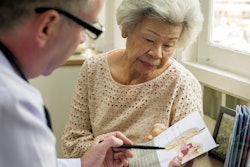
Providing individualized breast cancer risk estimates increased mammography use by almost 15% among women of racial and ethnic minority groups who are at high risk, according to a study published September 10 in JAMA Network Open.
Researchers led by Dr. Candice Schwartz from the University of Illinois at Chicago found that providing individualized risk estimates led to an increased mammography rate among women compared with before they received the risk assessment. As a result, this intervention could promote equity in mammography use and reduce racial disparities.
"This is one more piece of evidence to support the idea that we should be performing breast cancer risk assessment as part of routine primary care," co-author Dr. Kent Hoskins told AuntMinnie.com.
While screening mammography has led to an overall decrease in breast cancer mortality in the U.S., not all women have benefited equally. Black women in the U.S. historically have lower rates of receiving screening mammography, which leads to a higher proportion of late-stage diagnoses and lower survival rates. Data has also shown that Black women overall were significantly less likely to accurately perceive their breast cancer risk.
"These data suggest that providing underserved Black women with individualized breast cancer risk estimates may promote uptake of mammography," the researchers wrote.
The team looked at data from 188 women from 2013 to 2014. Out of these, 70 were Hispanic, 114 were non-Hispanic African American, and four were non-Hispanic white women.
Women received individualized risk estimates as part of routine primary healthcare at federally qualified health centers in medically underserved communities in Chicago. Out of the total, 98 women (52.1%) had an average risk of developing breast cancer and 90 (47.9%) were at high risk.
Overall, there was a nonsignificant increase in the mammography rate, from 38.8% during usual care to 48.9% following implementation of risk assessment. However, in a subgroup analysis, the mammography rate among women at high risk increased from 36.6% before risk assessment to 51.1% after assessment.
Of the women at high risk, 45.6% correctly perceived their risk status, compared with 71.4% of women at average risk.
The researchers said this is, to their knowledge, the first study to observe improved uptake of a clinical procedure following systematic breast cancer risk assessment in women without a personal history of breast cancer. They also noted that they did not observe any asymptomatic women gaining a false sense of security from this approach.
Hoskins said this data indicates that a simple intervention that does not cost much and is not technically demanding can improve the use of mammography among women who need it most.
"We would recommend that primary care practices incorporate this into standard well visits," Hoskins told AuntMinnie.com. "In fact, the U.S. Preventive Health Service recommends that, but it is vastly underutilized."
The team is now focused on developing tools and strategies to increase uptake of genetic counseling among women who are found to be at risk for hereditary breast cancer syndrome through population-based screening.
In an invited commentary piece, Dr. Elizabeth Valencia from and Dr. Sandhya Pruthi from the Mayo Clinic in Rochester, MN, said that future research should explore the performance of these strategies in other subgroups and in various clinical settings.
They also said studies should evaluate the association of disparities in insurance coverage and social determinants of health with increased mammography, supplemental screening, and genetic counseling, as well as whether patient navigation and education may be more effective.
"Reducing health disparities in women of racial or ethnic minority groups is a public health priority," they said. "Incorporation of easily available validated risk assessments into a busy primary practice is a scalable population-level strategy that will help promote health equity and change clinical practice."




















